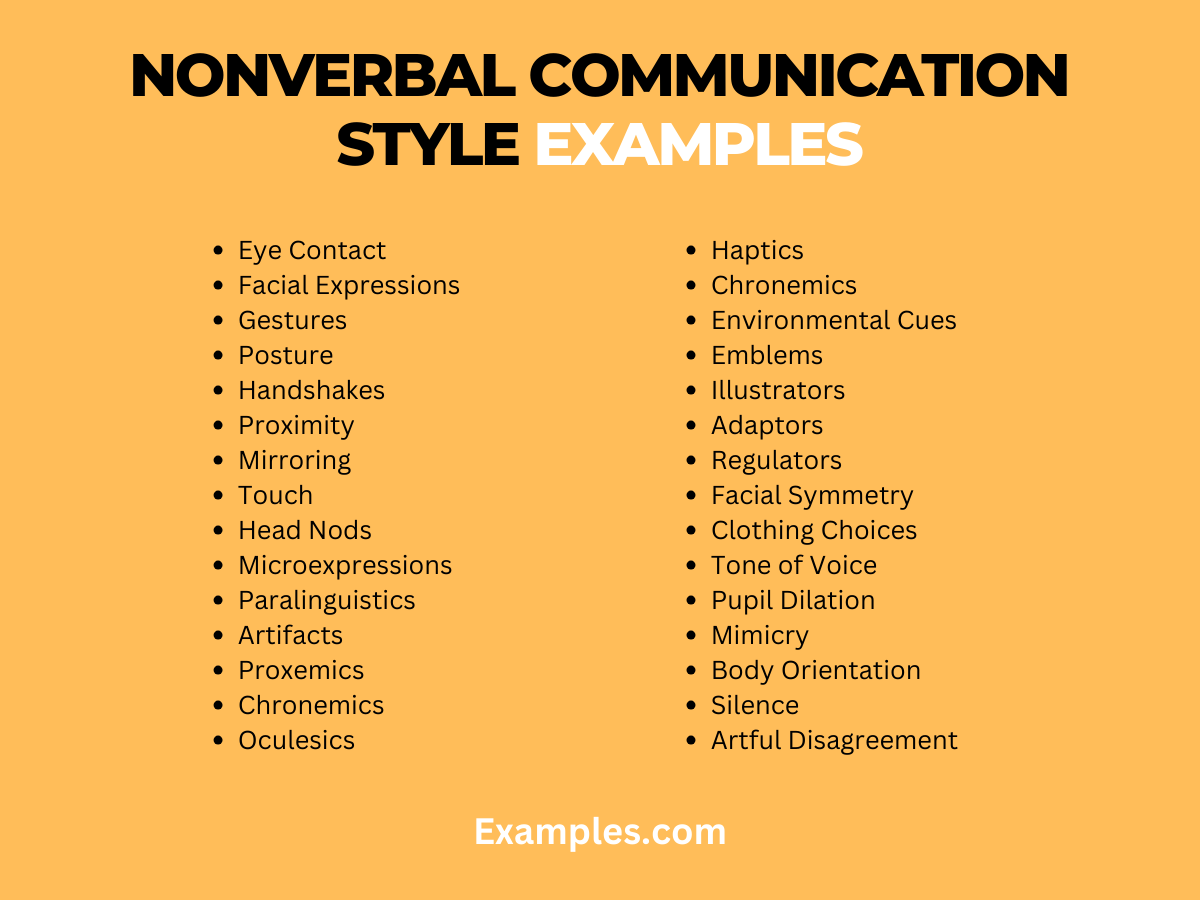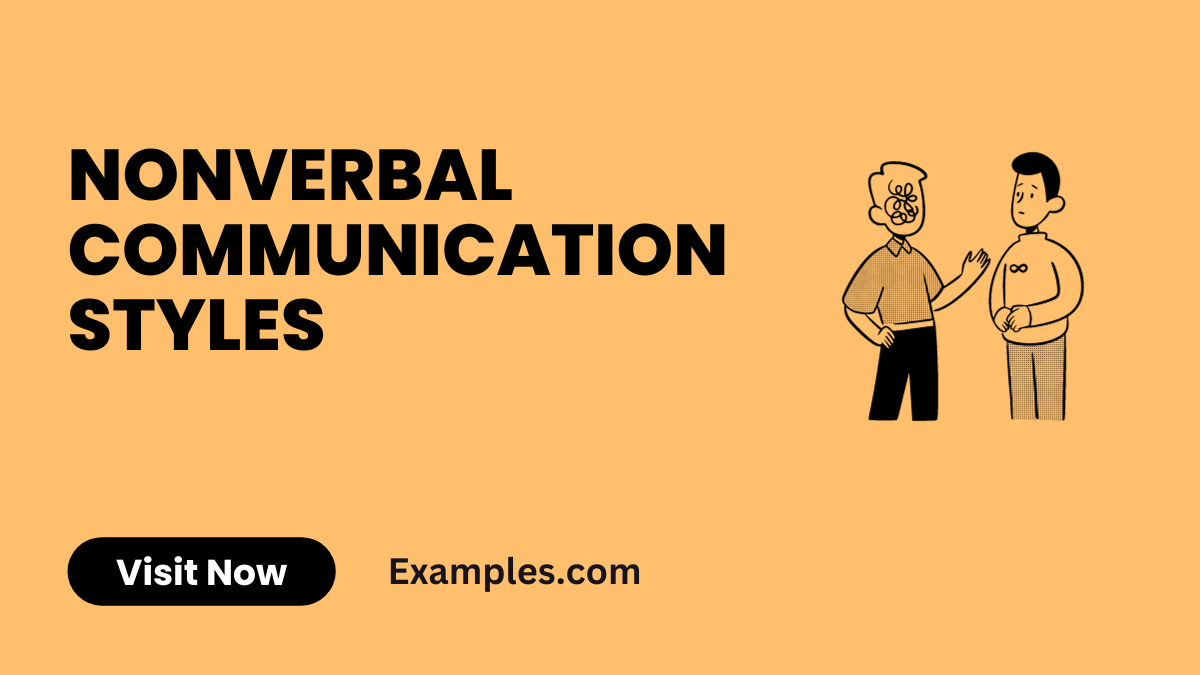29+ Nonverbal Communication Styles Examples
Unlock the nuanced realm of Nonverbal Communication Styles, an intricate language beyond words. In simple terms, it encompasses the art of conveying messages through gestures, expressions, and body language. Understanding this silent language is crucial for effective communication, influencing interactions in various contexts. Dive into the depths of Nonverbal Communication Styles to enhance your interpersonal skills and decode the unspoken cues that shape meaningful connections.
What are Nonverbal Communication Styles?

F
Nonverbal Communication Styles refer to the subtle ways individuals express thoughts and emotions without words. This includes body language, facial expressions, eye contact, and gestures. In essence, it’s the unspoken communication that complements verbal messages. Understanding Nonverbal Communication Styles is essential for grasping the full spectrum of human interaction, enabling individuals to convey and interpret messages accurately in diverse social and professional settings.
30 Nonverbal Communication Styles Examples

Unlock the power of nonverbal cues with these compelling Nonverbal Communication Styles examples. Explore diverse scenarios where gestures, expressions, and body language convey subtle yet impactful messages. Mastering these examples empowers you to navigate social and professional interactions with finesse.
- Eye Contact: Establish trust through confident eye contact, maintaining engagement without appearing confrontational.
- Facial Expressions: Express enthusiasm during presentations with smiles, ensuring your audience connects emotionally with your message.
- Gestures: Use open-handed gestures to convey openness and receptivity in conversations, fostering a positive atmosphere.
- Posture: Adopt an upright posture to exude confidence and command respect in professional settings.
- Handshakes: Forge strong first impressions with firm handshakes, signaling professionalism and confidence.
- Proximity: Adjust your proximity to match the context, ensuring comfort and avoiding invasion of personal space.
- Mirroring: Build rapport by subtly mirroring the body language of others, fostering a sense of connection.
- Touch: Apply appropriate, light touches to convey warmth and empathy, strengthening personal connections.
- Head Nods: Employ affirming head nods to signal active listening and agreement during conversations.
- Microexpressions: Recognize and interpret microexpressions to grasp underlying emotions in interactions.
- Paralinguistics: Master variations in tone, pitch, and pace for effective verbal communication that complements nonverbal cues.
- Artifacts: Leverage clothing and accessories to convey your personality and align with the context.
- Proxemics: Navigate spatial distances appropriately, recognizing cultural nuances in personal space preferences.
- Chronemics: Respect others’ time preferences, aligning communication with cultural attitudes toward punctuality.
- Oculesics: Convey interest and attentiveness through purposeful eye movements, enhancing engagement.
- Haptics: Utilize appropriate touch, such as a pat on the back, to convey support and encouragement.
- Chronemics: Respect cultural variations in time perception, adapting communication styles accordingly.
- Environmental Cues: Organize spaces to reflect professionalism or create a relaxed atmosphere as needed.
- Emblems: Employ culturally recognized gestures, like a thumbs-up, to enhance communication clarity.
- Illustrators: Enhance verbal messages with illustrative gestures, making your communication more vivid and engaging.
- Adaptors: Be mindful of self-touch behaviors, adjusting them to convey comfort without appearing anxious.
- Regulators: Use nonverbal cues to regulate conversational flow, signaling turns to speak and fostering smooth interactions.
- Facial Symmetry: Project confidence by maintaining facial symmetry, signaling emotional stability and reliability.
- Clothing Choices: Tailor clothing choices to convey professionalism, adapting to diverse social and professional settings.
- Tone of Voice: Vary your tone to convey emotions, ensuring alignment with the intended message.
- Pupil Dilation: Recognize pupil dilation as an indicator of interest or excitement in interpersonal exchanges.
- Mimicry: Build rapport by subtly mimicking others’ body language, establishing a connection through mirroring.
- Body Orientation: Signal openness and receptivity by facing others directly, fostering a sense of engagement.
- Silence: Master the art of strategic silences to convey contemplation or create impactful pauses in communication.
- Artful Disagreement: Express dissent respectfully, using nonverbal cues to soften the impact and maintain rapport.
Nonverbal Communication Styles Examples in the Workplace
Unlock effective workplace communication with these Nonverbal Communication Styles examples. Navigate professional interactions by mastering cues tailored for the office environment, fostering collaboration and understanding.
1. Active Listening: Demonstrate engagement in meetings through nodding and maintaining eye contact.
2. Professional Dress: Project competence and confidence with appropriate attire.
3. Hand Gestures: Enhance presentations by incorporating purposeful hand gestures.
4. Timely Responses: Convey urgency and responsiveness through timely communication.
5. Team Dynamics: Utilize open body language in team settings.
6. Leadership Presence: Cultivate a strong leadership presence through confident body language.
7. Proximity Awareness: Respect personal space while navigating the workplace.
8. Facial Expressions: Exhibit positivity through facial expressions.
9. Conflict Resolution: Signal openness to discussion with relaxed body language.
10. Elevator Pitch: Perfect your elevator pitch with a firm handshake and eye contact.
Nonverbal Communication Styles Example at School
Enhance the learning environment with these Nonverbal Communication Styles examples tailored for educational settings. Foster effective teacher-student and peer interactions to create a positive and engaging atmosphere.
1. Teacher’s Body Language: Communicate approachability through open and welcoming body language.
2. Student Participation: Encourage participation with encouraging gestures.
3. Classroom Proximity: Use proximity to manage classroom dynamics.
4. Visual Aids: Enhance understanding with purposeful visual cues.
5. Group Collaboration: Facilitate group work with inclusive gestures.
6. Eye Contact in Lectures: Maintain consistent eye contact during lectures.
7. Library Etiquette: Respectful silence signals library etiquette.
8. Empathetic Listening: Demonstrate empathy through active listening cues.
9. Presentation Skills: Engage students with dynamic presentation skills.
10. Nonverbal Discipline: Reinforce discipline through consistent nonverbal cues.
Nonverbal Communication Styles in Interviews

Elevate your interview performance with strategic nonverbal communication. Showcase confidence through a firm handshake and maintain eye contact to convey reliability. Subtly mirror the interviewer’s gestures for rapport and use open body language to express openness. Employing controlled facial expressions communicates professionalism and interest. Sit up straight to exhibit attentiveness and engagement and regulate your tone to convey enthusiasm. Remember, mastering nonverbal cues in interviews enhances your overall communication, leaving a lasting positive impression.
- Handshake: Boldly extend your hand, ensuring a firm grip to project confidence and professionalism.
- Eye Contact: Maintain consistent eye contact, signaling sincerity and active engagement throughout the interview.
- Mirroring Gestures: Subtly mimic the interviewer’s gestures to build rapport and establish a connection.
- Open Body Language: Sit with an open posture, arms uncrossed, to convey approachability and receptiveness.
- Controlled Facial Expressions: Keep facial expressions neutral, expressing positive engagement without being overly animated.
- Posture: Sit up straight with shoulders back to exhibit attentiveness and a keen interest in the conversation.
- Regulated Tone: Adjust your tone to convey enthusiasm and interest in discussing your qualifications and experiences.
- Proximity: Maintain an appropriate distance to respect personal space while still appearing engaged.
- Adapting to Cultural Norms: Consider cultural differences in nonverbal cues to ensure respectful communication.
- Appropriate Artifacts: Choose professional attire and accessories that align with the interview context and industry standards.
Why Nonverbal Communication Styles are Important in Daily Life?
Nonverbal communication styles play a pivotal role in daily interactions, influencing how we are perceived and understood. They convey emotions, attitudes, and intentions, contributing to effective communication. In social, professional, and personal contexts, mastering nonverbal cues enhances relationships, builds trust, and fosters clear understanding.
What Techniques Associated with Nonverbal Communication Styles?
- Body Language: Mastering gestures, posture, and facial expressions enhances communication clarity.
- Eye Contact: Establishing and maintaining eye contact signals attentiveness and sincerity.
- Tone of Voice: Modulating tone conveys emotions, emphasis, and helps avoid misinterpretation.
- Proximity: Adjusting personal space influences the level of intimacy and comfort in communication.
- Facial Expressions: Understanding and controlling facial cues aids effective emotional expression.
- Hand Gestures: Strategic use of hand movements adds emphasis and reinforces verbal messages.
- Attire and Appearance: Dressing appropriately communicates professionalism and cultural awareness.
- Touch: Appropriate touch communicates warmth, empathy, and fosters connection.
Tips for Effective Nonverbal Communication Styles
- Be Mindful: Stay aware of your nonverbal cues and their potential impact on communication.
- Consistency is Key: Align verbal and nonverbal messages to avoid confusion and enhance credibility.
- Adapt to Context: Adjust nonverbal cues based on the cultural and social context of the interaction.
- Practice Active Listening: Nonverbal cues enhance active listening, reinforcing engagement.
- Seek Feedback: Encourage open communication to receive feedback on your nonverbal communication.
- Embrace Diversity: Understand and respect diverse nonverbal communication norms.
- Control Nervous Habits: Be conscious of nervous habits that may distract from your intended message.
- Use Mirroring: Subtly mirroring others’ nonverbal cues can build rapport and connection.
In summary, understanding nonverbal communication styles is a valuable skill that can significantly enhance our interactions with others. From body language to facial expressions, these subtle cues often convey more than words alone. By recognizing and interpreting these signals, we can become more adept at navigating various social and professional situations.
To further delve into the world of nonverbal communication and its impact on human interactions, consider exploring the resources provided by the American Psychological Association (APA). With its wealth of research and insights into human behavior, the APA offers valuable information on the psychology behind nonverbal communication. Additionally, for those interested in the scientific aspects of this topic, Stanford University’s Department of Psychology provides a platform to explore cutting-edge research and studies related to nonverbal communication.



